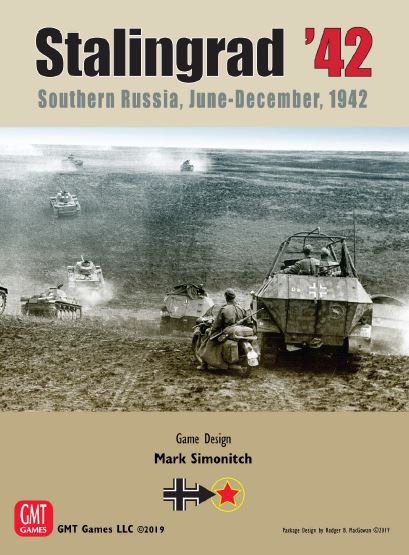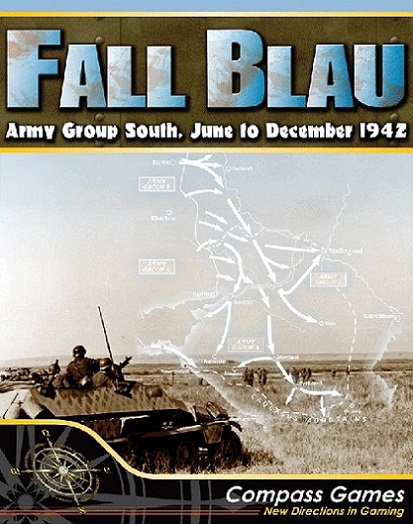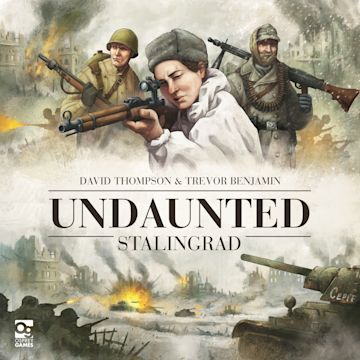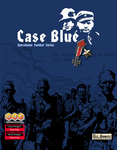When it comes to winter-themed wargaming, you have riches to choose from. Do you head to the Ardennes woods and recreate the Battle of the Bulge? Or venture with Napoleon into eastern Europe on his ill-fated march? Maybe you’d like to balance on ice blocks at the end of the world?
Today, though, we’re skipping all those for the cold city that turned World War Two decisively: Stalingrad. The ruinous clash between Soviet and German forces decimated the city, and put an end to the German offensive. Long, arduous, and full of strategic and tactical decisions, this battle is great gaming fodder, and while the titles below range from gigantic to tight, these Stalingrad war games all play great in front of a crackling fire while the snow drifts down outside.
Simonitch’s Stalingrad
We talked about Stalingrad ‘42 not all that long ago in our Zone of Control series piece, and it remains a standout in Mark Simonitch’s oeuvre. A division-level, I-go-you-go clash with nearly 600 counters, you’d be forgiven for thinking this one’s a beast of a game. And it can be, but only when you and your partner want to run the entire campaign. Otherwise, smaller scenarios serve as gateways, letting you get your feet wet with the vicious CRT and the Russian landscape.
landscape.
Both sides play with stark differences (just as, you know, really happened) with the Germans leveraging advancing railheads to scoot reinforcements up, while needing to use their elite units to pierce through Soviet lines in search of victory points. Those points are critical, as Germany must stay ahead of a climbing victory point counter, one that advances every round. In other words, if you’re not fighting forward, you’re falling behind. It’s a great mechanic to drive tension and urgency, and it ensures the Soviets have more to do than wait to get clobbered.
Stalin’s rough and ready fighters have numbers and the home field advantage, with savvy players getting opportunities to close nets around reckless German advances or bait the enemy into resource-churning struggles. Sure, if Germany sends their Panzers into that tasty city, those VPs could earn some breathing room, but now their supply lines are open for rear attack. The maps are big enough to allow this sort of strategy, making every game of Stalingrad ‘42 different.
In the earlier piece, I noted Stalingrad ‘42 can serve just fine as an opener to Simonitch’s ZOC Bonds system—wherein units affect empty hexes around them, especially with allies on the sides—and that holds true as 2024 draws to a close. This is a tried and true war game, one that can be approachable by newer players if smaller scenarios go first to work out the questions.
From there, well, you can fight this battle a thousand times and never see the same play twice.
A Little Chit Pull in a Big Game
Approaching Stalingrad from a different perspective is Compass Games’ Fall Blau (Greg Blanchett) – you’ll still get counters on the sweeping Russian plain, a bevy of scenarios ready to scale to your playing time and desired complexity, and that classic I-Go-You-Go turn style.
 Where Fall Blau makes its unique mark is in its stealthy chit-pull element, with the pull not controlling unit activation but, at the first time they enter combat, unit strength. This mild fog of war element won’t swing so hard to send your elite Panzers to an early grave, but adds color and individuality to your forces as they fight for breakouts. Without the ZOC Bonds of Stalingrad ‘42, you’ll see fewer defensive lines and more mobile assaults. It’s a different taste, but, like scotch and bourbon on a cold night, both are perfect.
Where Fall Blau makes its unique mark is in its stealthy chit-pull element, with the pull not controlling unit activation but, at the first time they enter combat, unit strength. This mild fog of war element won’t swing so hard to send your elite Panzers to an early grave, but adds color and individuality to your forces as they fight for breakouts. Without the ZOC Bonds of Stalingrad ‘42, you’ll see fewer defensive lines and more mobile assaults. It’s a different taste, but, like scotch and bourbon on a cold night, both are perfect.
One thing to consider between both of these war games is your eventual goal. Should you prefer playing massive, lengthy campaigns with sprawling maps, Fall Blau and its Kharkov expansion cover a vast amount of territory and can carry you all the way from June 1942 through Spring 1943 in a single game. It’s ginormous, but approachable with Blanchett’s rule set. What’s more, Fall Blau has elasticity: this isn’t a war game where the outcome is locked in, and you’re just trying to score some points to ‘lose less’ or ‘win more’. History can be rewritten here, should you possess the skill and luck to make it happen.
It’s the sort of thing memories are made from, and perfect for a long weekend in a cabin with a roaring fire.
Undaunted’s Campaign Packs a Punch
Both Stalingrad ‘42 and Fall Blau are dyed-in-the-wool war games, ones that can hold a newcomer’s hand but might be a tad intimidating for folks springing forth from Catan. Easier to grasp, if just as tactically rich, is Undaunted: Stalingrad. Released in 2022, Stalingrad takes the Undaunted deck-building and battle formula to the war-torn city in a very replayable campaign format. The game introduces new units and rules at a steady pace, giving players a gentle on-ramp while pushing them forward with consequential combat every step of the way.
Whether playing as the Germans or Soviets, you’ll begin with a slim force of named soldiers, scooting them around sections of the city by playing cards from your hand. Each of these cards represents those individual people, and should they get hit–by a D10 roll affected by distance and terrain–you’ll literally lose the card from your deck for the scenario. Lose them all, and your buddy’s wiped off the map. After the scenario, they might even be lost for good, forcing you to adapt even as reinforcements arrive and experienced survivors earn upgrades.
good, forcing you to adapt even as reinforcements arrive and experienced survivors earn upgrades.
A light yet dramatic narrative drives the campaign forward, with each side getting their own booklets stuffed with entries. The campaign can run more than a dozen missions, but your path will branch, and could complete sooner if one side proves dominant. Undaunted: Stalingrad gives its campaign added juice by giving each mission flexibility: even in a losing effort, you can preserve your troops or try to inflict targeted casualties, like staging a surprise assault to knock out the enemy’s sniper in hopes they won’t return in future levels, even as the enemy’s tanks rumble towards the objective. It’s a realistic twist, rather than the zero sum stakes present in most games.
The campaign also drives changes to Stalingrad itself, with terrain tiles permanently changing when bombarded by tanks, planes, or mortars. That Undaunted handles this by swapping out tiles rather than using stickers, markers, or other physical alterations preserves the campaign for future go’rounds. We’re also talking small numbers of tiles, units, and distances. You can play a round in under one or, for the bigger battles, two hours, making this an easy campaign game for weeknights or when you want maximum gaming value for your time.
If there’s a downside to Undaunted: Stalingrad, it comes as a series entry point. The cost here, as you’re getting a big box stuffed with greatness, is higher than Undaunted: Normandy or the recent Undaunted 2200: Callisto. Should you be concerned whether the skirmish gameplay on offer here will land with your partner, check out one of those titles first. But if Stalingrad and compelling, tactical play is a chocolate and peanut butter situation for you, then this is an easy recommendation.
A Legend Lives On
Labeling a game as part of the ‘Operational Combat System’ (OCS) is a marker of scope. The games in this series encompass worlds, providing rulesets at once enjoyable yet thorough enough to support small and large (and ginormous) campaigns modeling wars from the 20th century’s first half. Case Blue (Dean Essig) lands at the latter end, tipping the monster scales to bring an epic rendition of Germany’s 1942 southern offensive to your table. Getting this beast means swimming in counters, means enough maps to make any table seem small, and enough scope to occupy your gaming time for weeks upon weeks. And for the truly adventurous, you can even combine it with Guderian’s Blitzkrieg II if you never want to leave the Eastern Front.
 Venturing into this goliath, though, sees you engaging with the OCS in all facets. You’ll contend with supply issues as either side, needing to keep your lines fed and artillery armed. Employing mobile warfare tactics like keeping units in reserve to take advantage of breakthroughs or to scramble when your own lines splinter. All measured with historical accuracy in mind, but allowing flexibility to change your strategy and do things a different way. It’s an authentic approach that doesn’t handcuff you to existing outcomes nor bury you in a tome-like rulebook filled with exceptions and dragging steps.
Venturing into this goliath, though, sees you engaging with the OCS in all facets. You’ll contend with supply issues as either side, needing to keep your lines fed and artillery armed. Employing mobile warfare tactics like keeping units in reserve to take advantage of breakthroughs or to scramble when your own lines splinter. All measured with historical accuracy in mind, but allowing flexibility to change your strategy and do things a different way. It’s an authentic approach that doesn’t handcuff you to existing outcomes nor bury you in a tome-like rulebook filled with exceptions and dragging steps.
Sure, you’ll still have your CRTs, your dice rolls, your tweezers to keep the counters in line, but if you’re looking for a sprawling conflict that’s actually playable, Case Blue is a great one.
Now, a note: Case Blue has been out of print for a while, and it’s rather hard to get ahold of. I present it here because it’s a marvel. Anyone looking to purchase a copy ought to approach it as a gift or a collection centerpiece. I’d recommend adding it to your Noble Knight ‘Want List’ so you can decide, when a copy comes available, whether the time’s right to jump into this very deep, very rewarding game.
Stay Warm, Drink Hot Chocolate, and Fight for Stalingrad
War gaming in Winter is a far better experience than waging actual war in the snow, and Stalingrad games in particular present dynamic, engaging scenarios centered around the titular city but not confined to it. Stalingrad ‘42 and Fall Blau both let you explore objectives beyond the urban battlefield, whether streaking Panzer columns along the Russian steppes or mounting a behind-the-lines gambit to the west with your Soviet soldiers. Undaunted: Stalingrad, meanwhile, zooms into the street-level view, offering an invitation to war gaming novices with a narrative, replayable campaign.
It’s also the season for wishing, and for the true grognard in your group, Case Blue might deserve the top spot on their list. So get your boots on, grab your dice, and get ready for a chilly rumble with any of these great Stalingrad war games.
Read our previous article here!
